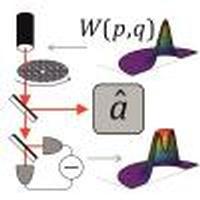Our official English website, www.x-mol.net, welcomes your
feedback! (Note: you will need to create a separate account there.)
How quantum is the “quantum vampire” effect?: testing with thermal light
Optica ( IF 8.4 ) Pub Date : 2018-05-30 , DOI: 10.1364/optica.5.000723 K. G. Katamadze , G. V. Avosopiants , Yu. I. Bogdanov , S. P. Kulik
Optica ( IF 8.4 ) Pub Date : 2018-05-30 , DOI: 10.1364/optica.5.000723 K. G. Katamadze , G. V. Avosopiants , Yu. I. Bogdanov , S. P. Kulik

|
The “quantum vampire” effect introduced in Optica 2, 112 (2015) [CrossRef] is discussed to understand whether it is really quantum, i.e., based on entanglement and “nonlocality,” or whether photon number correlations are enough. For this purpose, the effect was demonstrated with the classical thermal state of light. We have shown, both theoretically and experimentally, that if a thermal state is distributed among several optical modes, and photon annihilation takes place in one of them, it leads to photon annihilation in the rest of the modes as well. Thus, we conclude, that quantum vampire is actually a classical effect, based on photon number correlations like ghost imaging, Hong-Ou-Mandel interference, and so on.
中文翻译:

“量子吸血鬼”效应的量子如何?:用热光进行测试
在。光学引入的“量子吸血鬼”效果2,112(2015)[交叉引用] 讨论了解是否真的量子,即,基于缠结和“非定域性”,或者是否光子数的相关性就足够了。为此,在经典的光热状态下证明了这种效果。我们在理论和实验上都表明,如果热态在几种光学模式之间分布,并且其中之一发生光子an灭,那么在其他模式下也会导致光子an灭。因此,我们得出的结论是,基于诸如鬼影成像,Hong-Ou-Mandel干涉等光子数相关性,量子吸血鬼实际上是一种经典效应。
更新日期:2018-06-22
中文翻译:

“量子吸血鬼”效应的量子如何?:用热光进行测试
在。光学引入的“量子吸血鬼”效果2,112(2015)[交叉引用] 讨论了解是否真的量子,即,基于缠结和“非定域性”,或者是否光子数的相关性就足够了。为此,在经典的光热状态下证明了这种效果。我们在理论和实验上都表明,如果热态在几种光学模式之间分布,并且其中之一发生光子an灭,那么在其他模式下也会导致光子an灭。因此,我们得出的结论是,基于诸如鬼影成像,Hong-Ou-Mandel干涉等光子数相关性,量子吸血鬼实际上是一种经典效应。











































 京公网安备 11010802027423号
京公网安备 11010802027423号